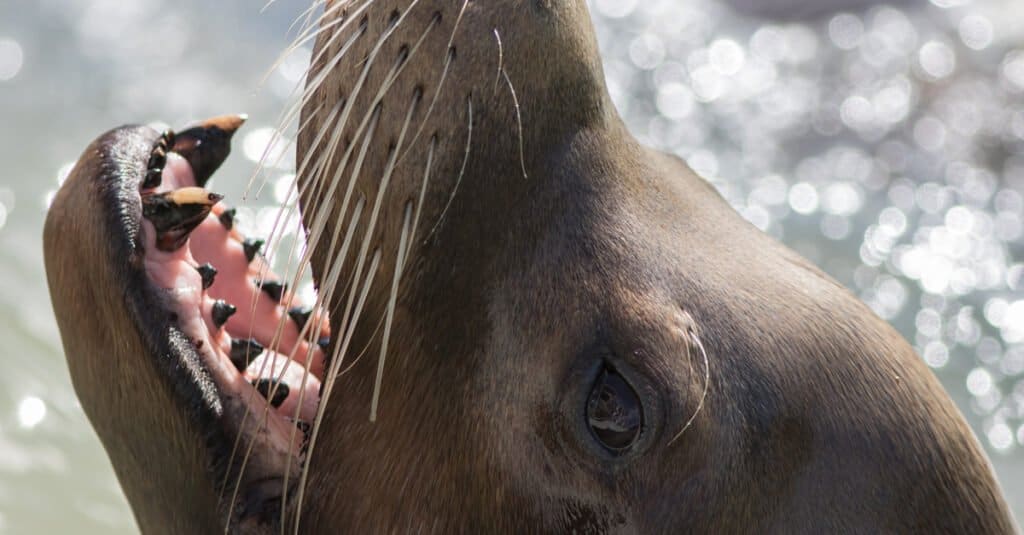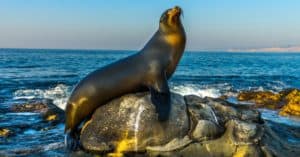Don’t get fooled by their incredible ability to swim and hunt underwater, sea lions are big marine mammals usually found along the the South Atlantic and Pacific coasts. Some species of sea lion also inhabit coasts of Galápagos Islands, Japan and Korea, and western parts of North America starting from southern coasts of Canada up to some parts of Mexico. Sea lions are intelligent and can follow rules. They can also show off their natural habits on cue, thus making them stars of many live marine shows, zoos, and aquatic tourist attractions.
Sea lions are pinnipeds, which involve 33 species of marine mammals, categorized in three families: true seals, fur seals and sea lions, and walruses. Sea lions are close cousins of seals and walruses, but they have their own differences. Despite being mammals, the body of a sea lion is constructed for sea life, equipped with a sleek, torpedo-shaped body and splayed, strong flippers, like four big swim fins in replacement of feet. In fact, this is where the group of pinnipeds got their name from: “fin-footed”.
Sea lions also share a similar dental formation with most mammals, and as omnivores, their dental formula also varies depending on the species and the type of diet they eat.
How Many Teeth Do Sea Lions Have?

Sea lions have from 34 to 38 teeth.
©Ian Dyball/Shutterstock.com
A sea lion has 34-38 teeth in total. The first two incisors of a sea lion are typically short and separated into two cusps by a deep cleft, whereas the third, outer, upper incisor is huge, conical, pointy, bent backwards, and canine-like.
Their canines look almost exactly the same, while their cheek teeth, the molars and premolars have one major cup in common. Despite primarily being carnivores that feast on fish and other sea creatures’ meat, sea lion molars are far less sharp than their canines. Often, sea lions use their pointy incisors and canines to grab prey, tear them to pieces, and then swallow them – they do not chew their food.
How Do Sea Lions Teeth Work?
A sea lion’s teeth are impressively sharp, designed mainly for cutting and tearing their food apart. Unlike most mammals and omnivores, their molar and premolar teeth are typically flat and not as sharp, but this isn’t a problem at all since they often swallow their food whole instead of chewing them.
The primary part of a sea lion’s diet is meat, which they can consume up to 50 pounds in a single day. They are solitary predators who feed on pounds of fish and squid per day, and rarely take huge animals like penguins which they can’t swallow whole without chewing. Some species of sea lions also eat crustaceans such as crabs, and animals with shells such as mollusks and shrimps.
Sea lions pursue schools of fish, spearing their prey with amazingly sharp teeth as they surge through with their jaws agape. They also use their long, rigid whiskers to wash out various crustaceans, crabs, and squid, as they forage through reefs.
What Do Sea Lions Teeth Look Like?

Like most carnivores, sea lions are equipped with sharp teeth.
©Andrea Izzotti/Shutterstock.com
A sea lion’s teeth are sharp and pointed, making them look like they have fangs.
Most sea lion species we see have little to no resemblance to lions, so where does the name come from?
Every species of sea lions is equipped with enormous and impressively sharp canine teeth, just like most carnivores. These canines look like fangs that lions and other meat-eating mammals also have. Sea lions also have a muzzle filled with rigid whiskers, as well as the ability to create loud roaring noises, all of which are lionesque qualities.
The South American sea lion is the most strikingly lion-like species. Its neck and head structure are dazzlingly lionesque. When the fur is dry, the South American sea lion’s “mane” is most visible, and there is little doubt that the name “sea lion” is well-deserved.
Why Do Sea Lions Have Black Teeth?

©Marcos del Mazo/Shutterstock.com
If you look at a sea lion’s teeth closely, you might notice that they look darker than they should be. But that is not always the case. In the beginning, sea lions have white teeth, but as time goes on, the bacteria in their mouths darken the enamel.
Sea lion saliva and gums are rust-colored because the germs themselves are black in hue, which eventually helps them develop black teeth and gives them dark pigment in their mouths. Symbiotically, the bacteria living in their mouths cleanse their mouths and the sea lion provides them with an environment to live in.
Do Sea Lions Teeth Need to be Brushed?
Sea lions are not immune to teeth cavities, plaque build-up, and gum diseases, just like humans, so brushing and cleansing a sea lion’s teeth is important to its well-being.
Cleansing a sea lion’s teeth in aquariums, zoos, and marine attractions is critical to help them keep a good set of teeth. You might have seen zoo staff brushing the teeth of sea lions, and the majestic sea mammals vulnerably letting them do so.
Because sea lions can’t wash their tongues and teeth, helping them wash and cleanse their mouths is critical. Water from the sea can irritate the epidermis, or skin, in the mouths of sea lions, as well as affect the digestive systems of these sea creatures, who live on the coast of the ocean.
Can Sea Lions Bite Humans?
It’s rare for a sea lion to attack a human, but it can be dangerous if a human comes within 8 feet of one. In 2019, a sea lion jumped out of the water and attacked a 13-year-old girl who was just taking silly pictures and having fun on the coast of California.
A sea lion’s bite doesn’t often have rabies, but it can cause some infections. Infections brought by a sea lion’s bite can cause swelling of the affected area, foul-smells coming from the wound, fever and nausea, and streaks of red outside the bite wound.
The photo featured at the top of this post is © Ian Dyball/Shutterstock.com
Thank you for reading! Have some feedback for us? Contact the AZ Animals editorial team.







